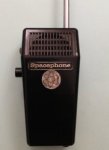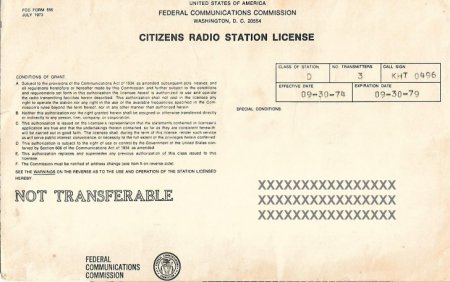Hobby Ra7dio3
HOME - RESERVED - DIRECTORY
My CB Radio Daze - How It All Started
My experience with CB Radio started on Christmas Day in 1964 when I received a pair of Spacephone walkie talkies. My best friend, who lived just next door, and I could now communicate with wireless ease. Well, sort of. The Spacephones had no squelch circuit and emitted that constant, loud “rushing” noise heard when you open the squelch on modern communications receivers.
Right away this was a major distraction because there was also no volume control! I did not know then that "real" CB Radio Operators keep that squelch wide open, but at least they have a volume control!) I felt kind of funny walking down the street carrying a little black box with a long antenna that made a loud racket. And how could you keep the unit on at night, waiting for important transmissions, when that loud "hiss" could keep the whole house awake? Adding to my frustration was the fact that several other area kids had received "quiet" walkie talkies with “noise limiting” circuitry.
What I found most fun about the units, noise or no noise, was that I could hear transmissions from other CB stations on the same frequency, which I later found to be Channel 14. I could hear base and mobile stations alike. My best friend’s mother, upon hearing this “interference”, remarked that we had been cheated. I guess she thought we should have had a private channel. I, on the other hand, thought that the more "interference" I received, the better.
I might add that during this period I became interested in Amateur (ham) Radio. I scraped together $1.50 and sent for the American Radio Relay League’s package that contained the Radio Amateur’s License Manual, How To Become a Radio Amateur, and a couple of other booklets, the names of which I can’t recall. If I had only taken the test back then, instead of 1982, I’d be a real “old-timer” instead of just old! I also spent hours reading the current catalogs from Lafayette, Burstein-Applebee, Allied, and others. Plus, there was a real electronics store just a few blocks away – unheard of these days!
We moved to a big Texas city for the 8th grade. The Space Phones made the trip also and continued to open the door to the world of CB Radio. There I was exposed to more local CB activity, with numerous base station antennas about the housing areas, and more than a few mobile rigs evident. I remember one guy in the next building had a 102-inch mobile whip bolted to a small metal toolbox for a base antenna. He had rocks in the box for weight. Looking back, I don’t think he had any type of radial system, not that I knew what that was back then.
One of my classmates belonged to a CB family, with a nice base station complete with a big ground plane antenna on the roof and a mobile setup. We used to tune around the band and listen to all the area radio traffic. I had to have one. I somehow talked my folks into ordering a small mobile CB radio and ground plane antenna. The antenna arrived first. It was a small 1/4-wave job and I assembled it in no time. I mounted it on a short mast attached to a clothesline pole. Then I waited and waited and waited for the radio.
It never arrived, but the bill did. My dad wrote the company a nice letter assuring them that the radio had not arrived and that we were not trying to scam them. For reasons I can’t remember, I never got that rig or a replacement. I would have to figure out something else. Oh, by the way, I wasn’t old enough to get a CB Radio license at the time, and I don’t remember my parents being too happy about getting one in their name so I could talk on the radio.
Making the rounds of the area pawn shops, I ran across a pair of walkie talkies at one of them. They were 300 milliwatt units if I remember correctly. I put them on layaway. When I got them 50% paid, the owner let me have one of them. I was now on the air! I’m not even sure if 300 milliwatts were still in the no-license-required category, but it’s too late to worry about it now. I made contact with quite a few area CB’ers. I had to ask what channel we were on because I had no idea. If I remember correctly, this set was on channel 13. I finally got the other 50% paid off and now the brothers and I could communicate.
Out of high school and on to college for a semester. That was just too much fun, so I decided to join the Army. School could wait a few years. Okay, so it only took me 20 years to get that degree! Anyway, after basic and advanced training at Fort Polk, Louisiana, I ended up at Fort Hood, Texas. There was a lot of CB activity in and around the area. I found a good deal on a 5-watt Midland handheld unit at a local pawn shop and had a blast talking around Fort Hood and Killeen with it. Later I bought a mobile unit and mag mount antenna and operated from the barracks. The metal bunk bed made a good counterpoise, I guess. Yes, I was "bootlegging" at the time, using a handle instead of a call sign.
Off to Germany, leaving my radio gear behind. I found a few guys in my unit in Germany who were stateside CB’ers and soon I had the urge to get back on the air. I stumbled upon a Montgomery Wards catalog and ordered a Midland 13-862b mobile rig and antenna. It took two months to get it but better late than never, I thought. I installed the unit in my car and I was on the air again. My co-workers chickened out and never ordered theirs. But that was okay because I found plenty of activity among area military personnel as well as German citizens.
As it turned out, CB Radio was very popular over there. If I had known that before I arrived, I could have had a truckload of radios sent over and made a good profit. One of my regular contacts was a German civilian employee of the fire department at Finthen Army Airfield, not far from my post – McCully Barracks – all about 20 miles or so south of Frankfurt.
It was legal for U.S. Military personnel to operate CB Radio in Germany as long as you got authorization from some German office. Somehow, most of us never got around to taking that formal route, and there was never any problem – as long as you didn‘t attempt a 102-inch whip antenna on your car. Amazing since German “sniffer” trucks were always on patrol to see who was watching TV without paying the proper TV tax.
One of my regular contacts was a U.S. service member living in government housing. He had a ground plane antenna on the roof. I don't know if he had permission for that or not. One day, while I was visiting, a neighbor came over to complain that he could hear us on his record player and tape deck. The problem was that he was trying to record some of his record albums onto tape. We went to his apartment to see if we could solve the issue. He had record albums, out of their dust jackets, spread out on his sofa.
Before long, his poodle, all excited about visitors in the house, jumped up on the sofa and ran back and forth across the albums. Problem solved! With all the records scratched up, there was nothing to record. We made a polite exit and never heard anything more about it. Several months before I left Germany, I mailed in the CB Radio license application so I would be legal once back home.
From Germany, I went to the Savanna Army Depot in Illinois. There was still a good amount of CB activity going on, so I ordered a Johnson 323 from a local store, having sold my Midland unit before I left Germany. The Johnson 323 was a very nice mobile unit for the period. These were still the “23 channel” days, by the way. I mounted the 323 into my Chevy Vega and I was back on the air. Several service stations in the town of Savanna had base stations set up for monitoring channel 9, the frequency set aside for emergencies and traveler assistance.
From Illinois, it was off to the Presidio of San Francisco, California, taking my trusty “323” with me. Of course, there was the obligatory trip back to Texas first. The roads were still filled with mobile CB’ers, chatting away with each other as well as the ever-present fleet of truckers. Many state, county, and local law enforcement officers had CB radios installed in their patrol vehicles. Some, I’m told, answered calls for assistance. Some just wanted to listen in.
The abundance of radio activity made the trip to California quite fun. I even called up R.E.A.C.T. on Channel 9 to get directions as I approached my destination. The year was 1975. For one reason or another, I didn’t do a lot of radio work during my two years in California, but I did fire it up for my trip back to Texas. We won't talk about the amount of oil that lemon Chevy Vega consumed! It was a much-discussed topic over the years.
From then on, I always had a CB radio in the car and operating, when taking any trip out of town. This was true even after I became a licensed Amateur Radio Operator. I enjoyed listening to the truckers talking as they traveled up and down the highways. Now I'm back on the CB full time.
For the general public, CB Radio had begun to fade away by the time I left the Army. Today, it’s just a shadow of its former self, but it’s a strong shadow with very active and dedicated enthusiasts.
Now, more about Amateur (ham) Radio. I've been a ham since 1982 and an Amateur Extra since 1983. I got all my testing out of the way during the first 4 months at the FCC Field Office in Dallas. I've got a stack of U.S. and DX QSL cards buried somewhere. I find digital communications - being a keyboard ham - boring as heck. Satellites? Cool but not for me. I appreciate the work the storm spotters do but that activity has never interested me, either. So, these days all I do is listen to Morse code on the HF bands to keep my speed at around 25 words per minute. That's fast enough for me.
The heterodynes of a busy AM CB Radio channel, with Morse code running in the background, is music to my ears!
KHT 0496

